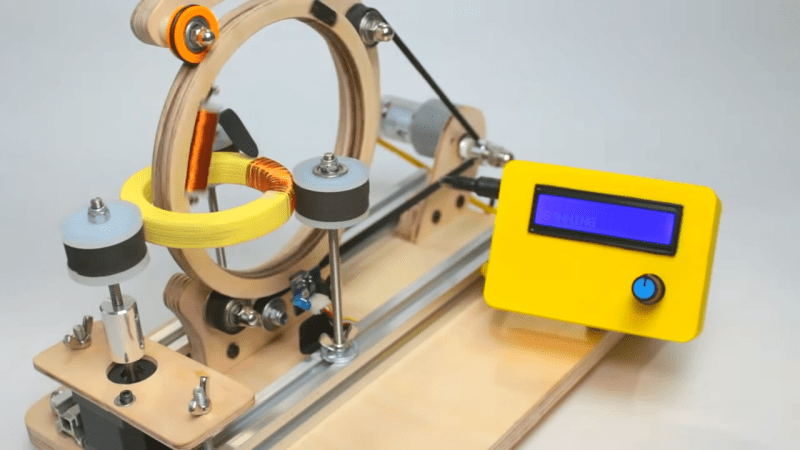Anyone who has ever wound a toroidal coil by hand can tell you that it’s not exactly a fun job. Even with the kinds of coils used in chokes and transformers for ham radio, which generally have relatively few windings, passing all that wire through the toroid time after time is a pain. And woe unto anyone who guesses wrong on how much wire the job will take.
To solve those problems, [Sandeep] came up with this clever and effective toroid winder. The idea is to pass a small spool of magnet wire through the toroid’s core while simultaneously rotating the toroid to spread the windings out as evenly as possible. That obviously requires a winding ring that can be opened up to allow the toroid form to be inserted; [Sandeep] chose to make his winding ring out of plywood with a slit in it. Carrying the wire spool, the winding ring rotates on a C-shaped fixture that brackets the toroid, which itself rotates under stepper motor control on a trio of rollers. An Arduino controls the rotation of both motors, controlling the number of windings and their spread on the form. lacking a ferrite core for testing, [Sandeep] used a plywood ring as a stand-in, but the results are satisfying enough to make any manual coil-winder envious.
We love tools like this that make a boring job a snap. Whether it’s cutting wires for wiring harnesses or winding guitar pickups, tools like these are well worth the time spent to build them. But we suppose when it comes to toroid winding, one could always cheat.
[via r/Arduino]
















One has to admire two intersecting hubless wheels.
For those with very tiny coils to make, YouTube sent me to: https://www.youtube.com/watch?v=F01FI52zFg0
That’s not a tiny coil, this is a tiny coil: https://static.rcgroups.net/forums/attachments/5/7/7/5/8/a2202001-122-%26%231084%3B%26%231080%3B%26%231082%3B%26%231088%3B%26%231086%3B%20008.jpg
(the motor on a 0.225 grams remote control plane: https://www.rcgroups.com/forums/showthread.php?961876 )
I build ham radio projects, and one my favorite parts is winding toroids! I don’t understand why everybody hates them so.
If I’ve got several to do it’s a relaxing bit of busywork while listening to a podcast or something. I can see how it would be a slog if you’re winding motor coils or power transformers rather than RF transformers though.
I do love his design, It’s fun to watch.
It’s a pain in the ass! 😂 I just wound a 9:1 balun with 30 ga. wire and the wire went everywhere.
It’s nicely built, but what would you use this for ? If I’m not mistaken, these chunky cores would normally be used for high current applications, but then you would need thicker wire than the small bobbin can handle.
the creator evidently has sufficient need for, and sufficient impatience with, the demonstrated OOM of core/AWG. the design seems very scalable EXCEPT for the flex of the spool-ring becoming a problem at smaller sizes. but that’s addressable with a clever gate design. the wooden core shown is also way larger than the minimum size possible for the machine, that’s why the spool is cut into the ID of the spool-ring
I can see a lot of thought and effort went into creating this. Excellent!
this looks like the Elektor drawing!!!
anyone else remember that issue??
There are a number of these toroidal winding machines on youtube, though unfortunately I have not seen any yet that wind toroidal cores in the sizes used for general “consumer” electronics, only the big ones.
The bobbin as used in this machine is not a very good way. It takes up a lot of space. In all the other machines I’ve seen, the rotating ring consists of 2 parts. One part has the guidance wheels, and a mechanism to control thread tension and location. The other part is a round spool, with the same diameter, and these parts can rotate compared to each other.
Then first the machine is wound backwards to put just enough wire on the spool, and during winding the spool with wire rotates with the guidance ring, and also unspools the wire in the amount needed.
For more, a simple search to get you started:
https://www.youtube.com/results?search_query=toroidal+winding+machine
There are different ways of wire tensioning. The smaller machines use a scheme more like in the video below, but the “extra” wire loop is held between plates to avoid entanglement. Because the plates are not present in the machine below you can however see more clearly how the loop is formed and then taken up.
The vid below is also from a home build machine :)
https://www.youtube.com/watch?v=S7xZjqG5OCg
Plier hammer just awesome. Couldnt watch anymore Cool machine though.
Wondering if some compromise between fully automated and manually by hand could be done?
For example the machine that was used to do the through-hole wiring of the Apollo AGC modules comprised a CNC positioning loop but the wire itself was inside a slim shuttle that was pushed and pulled manually through the loop by two skilled operators, sitting on each side of the machine. This can be seen in the ‘Computer for Apollo’ film on youtube.
So applying something like that to winding small toroids, the shuttle/bobbin could be filled with enough wire beforehand, and still have the toroid slowly rotated as per this machine but with a guide slot facing the operator, who just loops and loops the shuttle. A loop counter using a microswitch in the guide slot depresses when the wire is pulled snug.